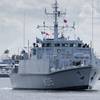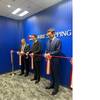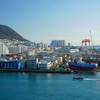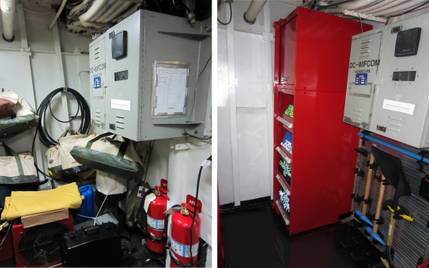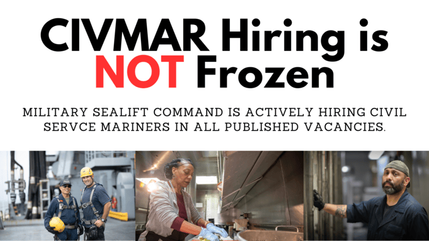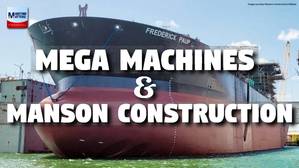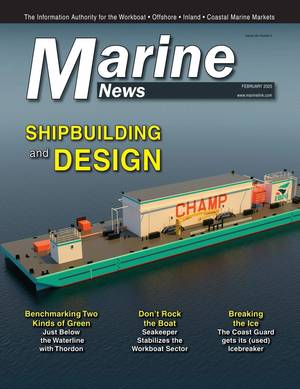Han Jong-chan assembles the massive blocks used to build ships at one of South Korea's huge and successful shipbuilding yards and has never been happier. Han has worked Daewoo Shipbuilding & Marine Engineering's famed shipyard on remote Koje island here for 18 of his 38 years, recently on night shifts as hefty orders force workers to man giant cranes and welding shops around the clock.
Despite a troubled past, a looming dispute with the European Union over subsidies and growing competition from China, the future is looking rosy -- particularly with Korean yards eyeing the potentially lucrative market for cruise ships.
The port of Okpo is synonymous with the Daewoo Group and the efforts of its now disgraced founder, Kim Woo-choong, in rescuing a state-run shipyard devastated by the global oil shocks of the 1970s.
Despite setbacks in the 1980s as the sector fell into a slump, the shipyard, helped by government subsidies, sailed smoothly through much of the 1990s, until exposure to weak Daewoo sister firms again spelled trouble.
But unlike siblings such as bankrupt Daewoo Motor, which was rocked by the collapse of the group in 1999, the shipbuilder has struggled back, and workers such as Han are logging the overtime to prove it.
"Yes, I feel tired physically," said Han. "But I am happy because the company is not going to lay us off as long as there is lots of work to do."
Han, like many of his 10,000 co-workers, expects the world's second largest shipyard to graduate from a creditor-led debt workout program in August.
Daewoo, like Korean rival and the world's top-ranked Hyundai Heavy, has won enough orders to keep its yards fully occupied for the next two and a half years.
In 2000, Korean shipyards won orders totaling 10.4 million cgt, almost 40 percent of global orders, against around 25 percent for Japan and 16 percent for the European Union.
"The financial crisis in 1997 gave Korean shipbuilders at least two gifts, that is, a high-quality work force and a weak won (currency)," said Angelos Cheliotis, who is at Okpo to oversee Daewoo's construction of a ship for his company, Anangel Shipping Enterprises S.A. of Greece.
Industry analysts say the Korean shipbuilding sector has also benefited from some structural advantages, for example it has suffered less than Europe or Japan from a shift of highly educated workers to white-collar jobs.
In segments like bulk carriers, tankers and containerships, analysts say European yards have lost the ability to compete with Korea and Japan is on a similar course.
"Japanese workers in the industry are about 10 years older than their Korean peers," said Ki Won-kang, vice president of Daewoo Shipbuilding. "Failure to attract young and able workers means the end of business."
The won's sharp decline against the dollar following the Asian financial crisis in 1997 equipped Korean yards, which export most of their ships, with tremendous price competitiveness. The exchange rate, which stands around 1,300 won per dollar, widened to nearly 2000 in late 1997 from about 800.
Like South Korea's lead in broadband, its relatively late entry into ships has helped as its newer yards offer greater efficiency than older rivals.
"Korean yards are the best organized," said Frank Eidsaether, an inspector from Det Norske Veritas (DNV), who is working at Daewoo competitor Hyundai Heavy. "As a result, quality is very high, delivery is very good and the construction period is short." Kim Chul-kyong, a senior sales manager at Hyundai Heavy, said Korean yards now can charge more for their ships than Japanese as they can better respond to shipowners' specifications.
"Customers began to pay more for Korean ships about three or four years ago," Kim said.
Ever-tightening environmental rules raised demand to replace old single-hulled tankers with double-hulled ships and demand for liquefied natural gas (LNG) carriers, starting in the late 1990s. Advantages of economies of scale also enticed shipping firms to place orders for bigger containerships and bulkers.
In a recent interview with Reuters, Han Dae-youn, Hyundai Heavy executive vice-president and chief marketing officer, said the world's shipbuilding industry was witnessing shortages of supply unprecedented in 20 years. "But the issue is whether producers can provide ships at market prices," he said at that time.
The European Union has accused the Korean government of providing illegal subsidies to shipbuilders, mainly through export schemes by state-run Korea Export-Import Bank, allowing shipyards to accept orders at dumping prices.
Earlier in May, European Union governments warned they would launch a World Trade Organization case against South Korea over what they view as Seoul's unfair trade practices.
Analysts in South Korea said the EU appeared to want to resume subsidies to European yards, which were suspended this year, and, at the same time, block Korean yards from entering the luxury cruise ship market long monopolized by the Europeans.
"It makes no sense that Europeans are being hurt by Korean yards because the two parties are making totally different types of ships," said Shin Young-kyun, Daewoo Heavy president and CEO.
Nicolas Saverys, chairman and managing director of Exmar NV of Belgium, said European yards had lost their competitive edge in ships Korean yards are now making.
"I don't believe the EU's accusation against Korea," said Saverys. "No single yard in Europe can build an LNG ship with the quality and the price Korean companies can offer."
Analysts say Korean yards have taken a step toward the luxury liner market claimed by the EU by receiving orders for RoRo passenger car ferries in recent years.
In May, Daewoo completed a ferry for Moby Lines of Italy worth $95 million, higher than the $80 million price tag for a mammoth 300,000 DWT VLCC. Hyundai Heavy has plans to build two RoRo ferries for Stena Lines of Sweden, and Samsung Heavy, which delivered such a ship to Minoan Lines of Greece in March, is building three more in its plant near Daewoo's yard.
Analysts and industry sources say the Koreans cannot afford to stand still as China ratchets up its ship output.
"We can't stay at where we are now because Chinese rivals are gnawing at our markets at a frightful speed," said Park Dong-hyuk, director at Daewoo's passenger ships division.
"We need to move up to higher value-added markets to survive and grow."
The worldwide market for cruise ships stands at about 20 to 30 a year worth $4 billion to $6 billion.
Korean analysts see it growing as luxury cruises to southeast Asian destinations rise in line with the increased popularity of such cruises in the Caribbean and Europe. - (Reuters)
Featured videos

SOV/CSOV Shipbuilding Market: Strong Growth, Volatility in Coming 5 Years

e1 Marine Drives Hydrogen Innovation in Marine
January 2025
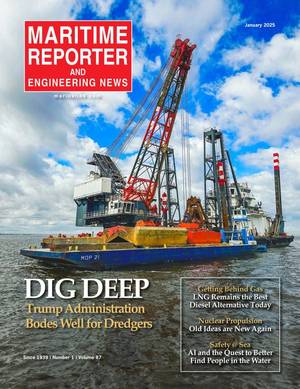

The orderbook for U.S. dredgers is about $3B, and according to DCA CEO Bill Doyle, the incoming political administration could help this niche maritime sector continue its bull run.
Read the Magazine
FuelEU Maritime: Baltic Exchange’s New Emissions Calculator
The Human Element in Maritime Decarbonization
Subscribe for
Maritime Reporter E-News
Maritime Reporter E-News is the maritime industry's largest circulation and most authoritative ENews Service, delivered to your Email five times per week



